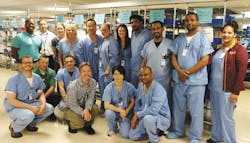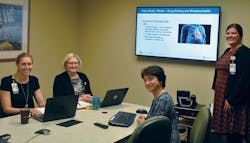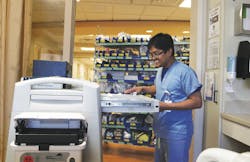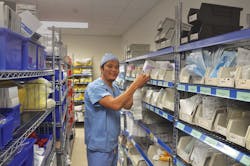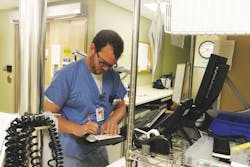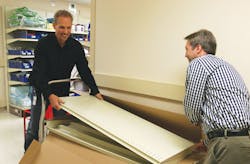Fairview puts the ‘i’ in teamwork: Investment
Business enthusiasts, corporate moguls and frequent viewers of television’s “Shark Tank” recognize the value in spending money to make money – and more of it, if possible. They call it “investing” in their products and people – and not necessarily in that order.
The Supply Chain team at Minneapolis-based integrated delivery network Fairview Health Services feels the same way but for far more altruistic reasons.
In healthcare when C-suite executives spot tremors in financial operations and spy pools of red ink in departmental budgets, they typically call for cuts in consumption patterns, contract prices, labor levels and even service lines.
To some that reaction seems like low-hanging fruit on one side or the lowest common denominator on the other. For Fairview, it motivates Supply Chain to take the road less traveled, to demonstrate the inherent value in what they do and the services they provide to justify investment as it leads to reduction.
Operating out of a converted railroad warehouse Fairview’s Supply Chain team has been spending more to spend less.
Fast Stats
Headquarters: Minneapolis, MN
Facilities: 9 hospitals and medical centers
- Fairview Lakes Medical Center (Wyoming, MN)
- Fairview Maple Grove Medical Center (Maple Grove, MN)
- Fairview Northland Medical Center (Princeton, MN)
- Fairview Range Medical Center (Hibbing, MN)
- Fairview Ridges Hospital (Burnsville, MN)
- Fairview Southdale Hospital (Edina, MN)
- University of Minnesota Medical Center (Minneapolis, MN)
- University of Minnesota Masonic Children’s Hospital (Minneapolis, MN)
- Grand Itasca Clinics & Hospital (Grand Rapids, MN)
Other facilities
- 40 plus primary care clinics
- 55 plus specialty clinics
- 54 senior housing locations
- 34 retail pharmacies
| Statistics | 2015 | 2016 |
|---|---|---|
| Licensed beds | 2,530 | 2,530 |
| Staffed beds | 1,524 | 1,541 |
| Inpatient admissions | 67,682 | 67,609 |
| Surgical cases | 78,157 | 77,445 |
| Outpatient encounters | 6.6 million | 6.6 million |
| Clinic visits | 1.55 million | 1.62 million |
| Total net revenue | $3.87 million | $4.36 million |
Leadership
- CEO – James Hereford
- CFO – Dan Fromm
- COO – M. Osman Akhtar
Supply Chain Management
System Vice President, Supply Chain: LeAnn Born
Joined organization: 2010
Previous position: Vice President, Contract Services at Novation (now part of Vizient)
Started supply chain career: 2000 as Standardization Consultant for Allina
Managers (at Fairview): Vice President has 6 direct reports (5 system directors plus Senior Administrative Assistant)
Employees/FTEs (at Fairview): 22,000+ for Fairview, 326 FTEs for Supply Chain
Conduit to CEO: Historically, Supply Chain reported through the CFO until June 2017. Effective July 2017, Supply Chain will report through the new COO who had yet to be named at press time.
GPO affiliation: Premier
Annual purchasing volume/supply expense (FY2016 vs. FY2017): 2016: $541 million vs. Jan-May 2017: $235 million (Note: Data do not include Fairview Pharmacy Services)
Annual purchase order volume (FY2016 vs. FY2017): 2016 total POs, 353,000 vs. Jan-May 2017 POs, 150,850 and trending toward 362,040
Percentage of purchase orders transmitted electronically: 99%
Percentage of requisitions processed electronically: 99.99%
Division functions: Accounts payable, purchasing, contracting, affiliate program, customer support & analytics (ERP production support), system central sterile services department, strategic sourcing, clinical integration project management (value analysis), sustainability, site operations for inventory management, distribution, projects, linen management, mobile medical equipment, receiving and delivery and mail services.
Purchasing and contract management: Centralized
Total annual operating expenses: 2016: $3.2 billion vs. Jan-May 2017: $1.4 billion and trending toward $3.4 billion (Note: Data do not include Fairview Pharmacy Services)
Say what now?
Supply Chain has been taking on more work and more customers over the last few years as part of a “center of excellence” approach to managing all aspects of supply chain activities, according to LeAnn Born, Vice President, Supply Chain.
“We’re spending more in Supply Chain, but less across the system by ensuring that people are working at the top of their licensure,” Born told Healthcare Purchasing News. “An example would be to have an inventory specialist do work that was previously being done by a department leader but at a lower hourly rate.”
Born’s team plugged data collected on supply chain expenses and hourly staff rate differences into return-on-investment formulas to create a pro forma recommendation that drew C-suite support for the plan.
“In most situations, budgeted FTEs were transferred from the departments where the work was done to Supply Chain,” Born said. “There were also some examples of work being done by so many people in such small portions of FTEs that the organization decided to invest in new resources to do the work, understanding that the return was based on supply expense reductions.”
Born acknowledged that Supply Chain’s reorganization several years ago to a corporate center of excellence (COE) model was not easy, but allowed the department to bring in “shadow supply chain services” that were being delivered throughout the organization. “We were able to see our work with fresh eyes and drive consistent services in areas we had not been aware of previously.”
Staff changes and “many ideas for new work we wanted to accomplish” motivated the restructuring, according to Born.
“We were able to modify positions and right-size our senior leadership complement with additions to supervisor-like positions. This recognized the talent of those not interested in people leadership, but ready for career advancement through project specialist roles,” she said. “We were aware of some people who were ready for advancement in their positions, but not necessarily ready for too big of a jump. These new positions allowed for a reasonable step up for them.”
Born categorized efforts as a “a redeployment of existing FTEs that allowed projects to get done more efficiently while ensuring that customer and staff needs were a priority on a daily basis.” This way, site-based supply chain leaders didn’t have to divert their attention from internal customers and employees to focus on such projects as product conversions, “leaning” PAR inventory locations and construction/remodel work. In short, Fairview Supply Chain embarked down a path toward managing all inventory locations, contracting and purchasing processes throughout the system from a centralized location that has drawn C-suite and clinical support.
Because Supply Chain added services to cover new inventory locations, new clinics brought into the IDN and the new Clinics and Surgery Center building, the department expanded a bit to handle the increased responsibilities. In fiscal year 2015, Fairview Supply Chain budgeted for 300 FTEs and $23.75 million in operating expenses, but actually recorded 307 FTEs and $25.43 million in operating expenses. Last fiscal year, they projected a budget of 302 FTEs and $23.19 million in operating expenses but actually booked 295 FTEs and $23.43 million. For the first three months of the current fiscal year, projections of 326 FTEs and $5.89 million are showing up instead as 313 FTEs and $6.04 million to date. New non-labor expenses were moved to Supply Chain from other departments, affecting the operating expense in excess of budget.
“We have focused on staff working at the top of their skill level and have created mid-level and other more economical positions that have actually increased service,” indicated Jessica Freitag, System Director, Supply Chain. “We have a culture of constant process improvement.”
Through their foundational efforts in solidifying operations under a COE model, Fairview’s Supply Chain team has delivered centralized leadership and consistent service to its customers throughout the IDN – hospitals, clinics, ambulatory surgery centers, home care and corporate services. These efforts are rooted in teamwork, process and transactional efficiencies, effective contractual oversight, centralized sterile processing services and dedicated supplier relationships that balance clinical issues with business issues to drive high-quality patient care.
Supply Chain relies on clinician supply chain ambassadors in selected areas and dedicated “supply chain clinical integration teams” focused on product decisions, and paired “accountable executives” with operational and physician leaders around service lines. Supply Chain’s internal framework forges successful relationships with their suppliers and group purchasing organization as they tap into these companies for consulting, data and technical acumen to reinforce their processes.
Because these strategies and tactics funnel into the organization’s aim to perform as a recognized “center of excellence,” HPN chose Fairview Health Services Supply Chain team as the 2017 Supply Chain Department of the Year.
Developing trust
Supply Chain’s “culture of constant process improvement” strives to minimize surprise and uncertainty, according to Freitag.
“We do try to standardize our approach to our work and our customers whenever possible,” she said. “We deployed Service Level Agreements across all sites so our customers know what to expect of us. It is good and preferable to be organized and have exceptional teamwork in your own department when you work with other departments as much as we do.”
To become a “trusted partner and asset” to Fairview, Supply Chain has helped to reduce clinical labor expenses as part of an overall goal of reducing non-labor expenses.
“We have taken on more work without asking for FTEs when the work was minimal to the area or we felt our work group could absorb it,” Freitag said. “I am referring to incremental additions as well as work previously done by others in the organization. I call it a ‘reduction’ and not ‘maintenance’ because of the amount of work we’re talking about and because we have reduced work for clinicians and leaders across the organization so they can focus on their core duties.”
Examples include adding equipment to the centralized mobile medical equipment model managed by Supply Chain, absorbing additional customers with Inventory Specialist support, adding linen support to new areas and assuming responsibility for capital requisitioning, she noted.
“There has been a significant give and take over the years where we identify efficiencies and instead of reducing staff we create capacity to do more to support our customers,” Freitag said. “We are always being asked to do more because we are good at what we do.”
Of course, Born, Freitag and the entire Supply Chain team strive to “understand the tipping point between absorbing and over-loading.”
Team-oriented
Following the results of an annual Towers Watson employee engagement survey last year, Supply Chain chose to focus on improving teamwork in a quest to raise further the fairly high score they received. Participating in a series of team-building projects that included a “buddy system” and “job shadowing,” Supply Chain learned ways to become more cohesive and function as a unified group. This has benefits within the department and strengthens relationships with other departments. Ultimately, it supports the organization as it cares for its patients.
Supply Chain’s buddy program generated a particular success story with inventory specialists across different regions at Fairview. Tina Good, Supply Chain South Regional Manager, cited efforts by Inventory Specialists Jeff Kolhei at the Maple Grove campus in the North Region and David Overton at the Fairview Southdale campus in the South Region as particularly noteworthy.
“David and I have been working together at Southdale doing a major re-label and cycle counting,” Kolhei noted. “I’m helping with this project at another site and recognizing that there are so many extras to a central supply room, like purging and bin-to-bin transfers and the list can go on and on. One great bonus is that I have the chance to connect with all the Inventory Specialists at Southdale. They were just names on a paper before I was paired with David. Now I can truly say that I know Tenzin [Ngawang], Aldo [Lopez], Jason [Fields] and Andrew [Dealy]. So much extras to the central supply work, but you earn so much extra in work relationships especially when you get to work with people in person and learn from each other.”
Supply Chain launched the buddy system for inventory specialists to start, according to Freitag.
“We paired newer people with more experienced people and paired like roles at different sites with one another as a learning and relationship opportunity,” Freitag said. “We also have paired Purchasing Specialists with Inventory Specialists through job shadowing efforts. These two roles connect so much electronically and we wanted each to understand what the other does better.”
Accounts Payable, Purchasing and P-cards also focused on teamwork.
“The benefits gained from our deliberate focus on teamwork include increased efficiency and the ability to focus different thought processes on a common problem,” said Sandy Compton, Director, Accounts Payable and Purchasing. “The team better realizes that when we work together we’re able to accomplish more than we could on our own. Our teamwork has produced outcomes that are more efficient, thoughtful and effective. Each team member is benefiting from the trust they’ve built with one another, the respect they have for every Supply Chain team member across the system, mutual support they have and all have a great sense of accomplishment at the end of each day.” This group determined how to reduce receipt accruals and increased use of prompt-pay discounts, Compton added.
Clinical customer service
Supply Chain Clinical Integration (SCCI) teams form the nucleus of Supply Chain’s relationship with doctors, nurses, and operational leaders to focus on product evaluations and decisions, service line operations and other value analysis efforts, according to Born.
In many cases, Supply Chain uses a triad approach by partnering with an operational leader and a physician leader to concentrate on meeting customer needs and pursuing continuous improvement opportunities across the organization. Efforts span hospitals, clinics, ambulatory surgery centers and home care operations. Supply Chain also recruits “accountable” executives to “bring visibility to the project as a priority, assign responsibility to operational leaders and help to break down barriers when they pop up related to the project,” Born said. Fairview appoints accountable executives to those challenging projects expected to drive more than $100,000 in savings.
Supply Chain contributes value analysis facilitation, contracting, transactional efficiency and business intelligence to leverage data in making decisions, she added. Key success stories from this process emerged in the areas of spine services, cardiovascular services, surgical services, and the construction of Fairview’s Clinics and Surgery Center (CSC) facility about two years ago.
Fairview operates 25 SCCI teams across the system that range from multi-purpose teams to those focused on value analysis to those that meet on an ad hoc basis, according to Born.
“These teams manage the requests for new products, identify standardization opportunities either to fewer suppliers or to fewer products from a single supplier, and identify and eliminate unnecessary variation in how products are used,” Born said. Unique SCCI Teams generated cost reductions that ranged between $400,000 and $2.5 million for products purchased by their service line in 2016, she continued. Consensus-driven value analysis teams have generated more than $50 million in savings during the past several years and are on track to meet a savings goal of $10 million this year, she added.
In the spine segment, participating spine surgeons provided feedback on implant criteria and product differentiation among a variety of suppliers for the $14-million annual expense category.
“The first phase of our spine work created price integrity,” said Sofya Mikhelson, System Director, Supply Chain Contract Services. “Attention was placed on ensuring that similar products were priced similarly through the contracts. Price benchmarking suggested that even without consolidation of suppliers, we could achieve better pricing if our surgeons were engaged and willing to eliminate suppliers that would not meet our benchmark price points. The next phase will attempt to consolidate to fewer vendors.” The spine project generated more than $2.5 million in cost savings and served as a baseline for further progress within the category as well as a blueprint for how to approach other areas down the road, she added. Total joints (hips and knees) may represent a future area. “We were not ready to reduce the number of suppliers in the total joint space and felt that we had decent pricing for an all-play construct model,” she noted.Through a dedicated Clinical Integration Project Manager, Jen Schnabel, and Contract Specialist, Georgia Cochrane, Supply Chain has worked with Fairview’s cardiovascular service line leaders to help them more effectively manage costs in such product areas as cardiac rhythm management, drug-eluting stents and heart valves. Born attributed some of the successes to Cardiovascular Services being recognized across Fairview as a system service line with physicians belonging to a common group. She linked similar successes in the laboratory and radiology categories to shared clinical services across Fairview that benefit from coordinated supply and equipment decisions.
In a joint venture with the University of Minnesota Physicians group, Fairview opened a Clinics and Surgery Center (CSC) facility last year where Supply Chain played an integral role in planning, designing and implementing patient-centered care. Supply Chain manages and restocks exam room and specialty carts and other key supply storage areas on a daily basis for the facility. This amounted to $1.4 million in additional inventory alone, and increased Supply Chain’s overall expense stream to $23.6 million in May, up from $16.6 million back in December 2015. Prior to opening the CSC in February 2016, Freitag indicated that “clinical staff used to buy many items on P-cards and have other clinic staff manage supplies.”
Under the new system, four CSC delegates meet with supply chain representatives, physicians and operational leaders to make decisions for the building. Inventory Specialists, overseen by Regional Managers, support supply chain operations for all of the clinics and ASCs.
Physician employment status really isn’t a factor in how Supply Chain works with physicians, Born emphasized.
“We partner with employed physicians, academic physicians and independent physicians,” she said. “Regardless of who their employer is, we try to engage all physicians in a similar way. We engage with them for ideas, bring them data, ask them questions, seek understanding for observations of variation in how products are used and commit to ensuring that their clinical requirements are met by the products we offer.”
Those efforts reinforce the trust Fairview Supply Chain has gained with clinicians, but Born is quick to spread the credit among her team as well as share it with her predecessor “who established a positive reputation a long time ago,” she said. “We have long felt the support from our C-suite and clinical department leaders.”
Tech infusion
Supply Chain wields a lot of technological capabilities in various areas throughout the system, including automated drug and supply cabinets from Omnicell and Pyxis for higher-cost products (but two-bin Kanban for lower-cost, and medium- to high-velocity products), and a materials management information system where they also automate daily procure-to-pay transactions via electronic data interchange (EDI) and produce more than 1 million automated transactions each year. Currently, their EDI transaction rate stands at 99 percent, which allowed Supply Chain to eliminate one FTE through attrition. GHX has recognized Fairview Supply Chain as part of its national Top 50 “Best in Class” for the past several years and as a member of the exchange’s elite “Millennium Club” for two consecutive years.
To manage new product requests and product evaluations, Fairview Supply Chain relies on MedApproved’s web-based application to navigate the process system-wide.
“We needed a documented, consistent approach to ensure appropriate review of requests by SCCI teams and a clear way of making decisions,” said Kelly Nelson, System Director, Business Development and Project Management, who left Fairview at press time last month after 13 years of service. MedApproved’s online application offered an “affordable way of accepting requests and allowing collaboration” among and within the SCCI teams, Nelson added.“Challenges were faced in the past where one site would make a decision to deny a request for a new product and then another site would approve it,” Nelson recalled. “Fairview’s current process allows us to document how the decision was made. It is possible to use products for certain procedures, but a product should not be limited at one site and allowed at another site for the same procedure.”
Supply Chain uses Blue.Point to record and analyze how products are used. “Blue.Point helps us benchmark the price we’re paying for items, but more importantly, helps us understand variation in how we are using products and offers evidence-based alternative ways to use products,” Born said. Endomechanical products represent one example. “Blue.Point reminds us to look at the use of articulating products to see if there is an opportunity to use a straight product or to fire the maximum number of times allowed prior to opening a new stapler. This helps us save money in ways that go beyond the price we pay for a product.”
Blue.Point usage pairs well with MedApproved, according to Laurel Sampson, System Director, Business Development and Project Management. “MedApproved is helping us decide what to bring into the organization,” Sampson said. “Blue.Point looks at how we use the product.” Supply Chain plugs into the Fairview’s Oracle/PeopleSoft enterprise resource planning (ERP) system to analyze expense data through its group purchasing organization (GPO) tools from Premier. With those tools, they can determine whether they are accessing the optimal contract and pricing tiers, can identify variation in supplier and item use within product categories, and can look at comparative effectiveness data tied to clinical outcomes and quality.
Supply Chain pulls data from Fairview’s electronic health record system “to look at what products are used for different procedures and by different physicians,” Born indicated. “This is blended with the price we paid for these products through our ERP.” They’ve addressed peripheral and biliary stents, drug-eluting stents, pacemakers and ICDs, endomechanical products and vessel-sealing devices to date. “We have looked at differences in quantity per case and sizes of products used,” she continued. “Data do not usually tell us which product is most effective. However, when we identify variation, it allows us to have conversations with physicians to understand if there are reasons for different products or if physicians were simply unaware of the products being used by their colleagues or unaware of the cost of the items.”
Back in 2012, Supply Chain expanded its contract management system to function also as a system repository for product and purchased services contracts. The system’s automated tools enable them to review supplier performance expectations and manage expirations, according to Mikhelson. Furthermore, Contracting developed a risk assessment tool that helps business owners understand specific contractual language when they agree to work with the IDN.
Several years ago, Supply Chain also established a collaborative “Per Patient Day” shared-risk-and-reward relationship with Covidien (recently acquired by Medtronic) with incentives around availability and consumption patterns. The partnership has been so successful that they continue to add certain commodity products to the growing program, which now exceeds $1 million in Medtronic products, according to Born.
Benchmarking productivity
As an organization progresses through performance improvement projects additional process efficiencies can be challenging to find. Fairview’s Supply Chain team found that to be the case after years of Lean and Six Sigma projects. Another challenge involved finding a realistic comparison group to use as an external benchmark to assess productivity, according to Freitag.
Rather than look outside they chose to look inward, Freitag continued, which positioned the department well for handling expanded responsibilities as Fairview grows through acquisition and patient volume.
“In the last year, we developed a cost per unit of service model that benchmarks us internally,” she said. “This has worked well for us because we are intimately aware of the services provided at each site. We have used this information to decide when open positions do not need to be replaced and to reconfigure teams based on workloads.”
facilitates
See Sidebars:
Teamwork touted by Fairview Supply Chain
Fairview Supply Chain spotlights Sterile Processing
Fairview Health’s supply chain team shares milestones, mindsets that motivate success
About the Author
Rick Dana Barlow
Senior Editor
Rick Dana Barlow is Senior Editor for Healthcare Purchasing News, an Endeavor Business Media publication. He can be reached at [email protected].


